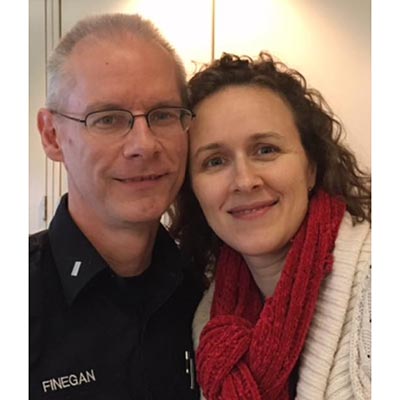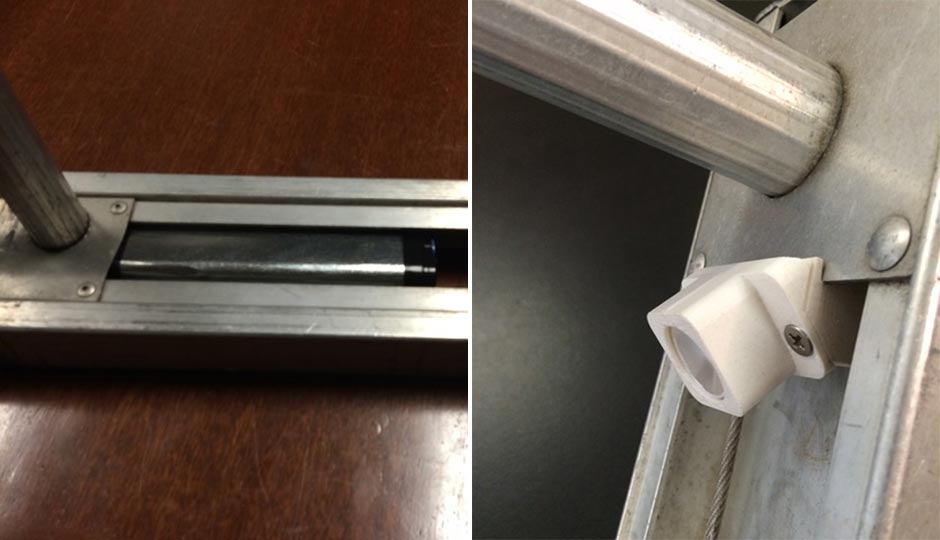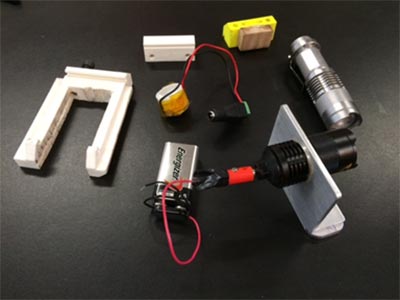This Philly Paramedic Is 3-D Printing His Bright Idea to Save Lives
Bill Finegan’s bright idea was born from the darkest of tragedies.
The Philly Paramedic Lieutenant was in his first few years on the job on September 19, 1994, working as a paramedic. That night there was no moon, Finegan recalls, and the air was still and choked with humidity. At around five in the morning, his unit got the call.
A fire was ravaging a row home on Catharine Street. Flames licked all three stories but what Finegan saw immediately when he pulled up was smoke. Pluming columns of it spilled out the windows and settled at the base of the house like a moat.
He would research it later. The smoke refused to rise because of a weather condition called “thermal inversion.” But at the time, all he knew knew about the situation was that he could barely see a thing.
Finegan and his team started treating the women and children who had escaped from the house. Kids had jumped out of windows. Mothers had thrown babies down to relatives with outstretched arms. A handful of people needed treatment for cardiac arrest and multiple fractures.
Once the fire was extinguished, the building cleared and the patients transported, the response team realized one person was unaccounted for, a toddler named Charmaine. They checked everywhere they could think of. With neighbors’ houses, cops, local ERs. They searched the building again and again and still no Charmaine.
Then the sun rose. They found her hours after the initial call at the base of the back of the building. Finegan believes she had jumped out the third story window. She landed in the back yard behind an ivy-covered fence where debris then fell and concealed her body.
That horrifying discovery made the news and led to a fire department investigation. It also firmly implanted in Finegan’s mind. The memory would often resurface while he was lying in his bunk during night shifts, hovering between consciousness and sleep. Years later, he’s tormented by details from that fire. He remembers the exact layout of the building (18 feet by 40 feet). He remembers Charmaine’s age (she was four). And he remembers her nickname, Chae-Chae, which he can’t say without his voice catching in his throat.
That night forever changed Finegan’s perspective on his duties as an emergency responder. On subsequent runs he saw the darkness instead of the light, the spaces that could be filled with the victims who’d leapt before he arrived. That night was still with him 20 years later when he was on another job in North Philly in 2014. Climbing a ladder, holding a flashlight in one hand, he had a revelation:
Take a ladder and light it up.

Left: An early design of Finegan’s innovation. Right: A CAD rendering of the light.
The concept might sound obvious, but to Finegan’s knowledge no ladder with an integrated lighting system existed. From years on the job, he understood there were plenty of places in Philly, like that ivy fence that hid Charmaine, where light from streetlamps just weren’t enough. They didn’t penetrate back alleys, or they sometimes went out or were oddly spaced, leaving black holes into which people who needed help could disappear.
His idea was to integrate LED lights into the Fire Department ladders so wherever a firefighter or paramedic had to climb, there would be ample light to flood the area around them. Emergency responders wouldn’t need to clear out spaces in their vehicles for portable lighting or lug around a finicky generator. Plus, Finegan thought, a person whose house is on fire would feel more comfortable climbing out of a high window onto an illuminated ladder than a dark one. When there’s death behind them, people are terrified.
“[Light] makes us feel safer. You know what you’re supposed to be doing,” Finegan says.

Bill Finegan and his wife, Clare.
So Finegan started tinkering, cracking open flashlights and examining their innards. The process hearkened back to his childhood in Bensalem. His dad was a machinist who became something akin to a self-taught engineer for the old Mack Trucks plant in Allentown. Their neighborhood streets swarmed with kids. One day, when Finegan was 3, his dad got the idea to rig the back-up lights of his ’69 Volvo station wagon with a doorbell he bought from a hardware depot. That way, whenever he backed up, the noise would go off and children knew to get out of the way.
“Kids in the neighborhood would call it ‘dingdong,’” says Finegan, laughing.
Finegan cherished those afternoons working on homemade contraptions with his dad. When he started playing around with his own invention, slicing ladders apart with hacksaws, he let his kids take turns finishing the cuts. He and his wife, Clare, have nine kids total, ranging from ages 24 to 19 months — and with another one on the way. Clare home-schools the kids that still live with them in Chestnut Hill. Physically making and building things are foundations of their education.

Left: A prototype of the lighting system’s battery pack. Right: A 3-D printed prototype of Finegan’s light design.
After a few months of work, Finegan took powerful LED lights and brought them to a machine shop with his design concept, but they couldn’t give him the finesse he needed. He tried flashlight manufacturers and ladder manufacturers, but no one seemed to see the potential. On a whim, he called NextFab last September, a local workshop with 3D printing capabilities. After a few months of partnership, he had a patent and CAD design for a retrofit kit that can outfit a standard 12-foot straight ladder with 10 LEDs.
He and his business partner, Pat Creed, plan on selling the kits for $500 to fire departments across the United States. Since Finegan works for Philly, he wants to take the money from every kit he sells in the suburbs and use it to outfit one of Philly’s ladders. The Fire Department has agreed to put the ladders through their equipment test and potentially use them in a pilot program as soon as Finegan finalizes the design. He says the design could be wrapped up in a month or two.
Though he understands the business potential, Finegan’s focus isn’t just on making money. His father never patented his backup alarm. When it hit the markets and got popular, he told his son, “You don’t need to get rich to have done well.”

Finegan’s kit, deconstructed.
Finegan believes this as gospel. He hopes after this product takes off, he can spend time developing another idea he had after a Philly firefighter, Joyce Craig, died in a fire last December. He wants to outfit firefighters’ breathing apparatuses with LED lights that flash and strobe when they reach low air or hit their mayday button. He’s got a patent on that one, too.
Finegan’s time as a paramedic wasn’t all innovation and inspiration. Though he’s since been promoted and doesn’t make Medic runs anymore, he still cries openly when talking about Charmaine, a death that occurred nearly 20 years ago. He’s suffered PTSD from the stresses of the job. Sometimes the details of those deaths still seep into his late night reverie like they happened earlier that evening.
But over time, Finegan learned how to use that tragedy to motivate him, and he stayed on the job for years, saving lives and thwarting death in the middle of the night. Even in his lowest moments, he thrived in crisis. He was calmest when everything around him was chaos. Though Finegan’s a lieutenant now, he knows Philly paramedics are still like him: Fearless in the moment, but when the action subsides, the deaths they witness weigh on them. Finegan understands. He’s been there. And he sees his invention as a way to save both people, like Charmaine, and emergency responders from suffering.
“I would be doing this even if I didn’t make a penny because I’m still trying to save Chae-Chae. I’m trying to prevent that from happening again.”
Follow @emmajanepettit on Twitter.


